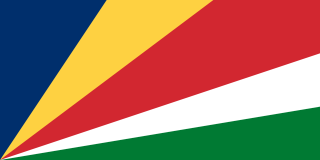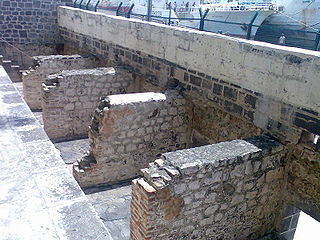
Seychelles, officially the Republic of Seychelles, is an island country and archipelagic state consisting of 115 islands in the Indian Ocean. Its capital and largest city, Victoria, is 1,500 kilometres east of mainland Africa. Nearby island countries and territories include the Comoros, Madagascar, Mauritius, and the French overseas departments of Mayotte and Réunion to the south; and Maldives and the Chagos Archipelago to the east. Seychelles is the smallest country in Africa as well as the least populated sovereign African country, with an estimated population of 100,600 in 2022.

Coolie is a pejorative term used for low-wage labourers, typically those of Indian or Chinese descent.
Indo-Caribbeans or Indian-Caribbeans are people in the Caribbean who are descendants of the Jahaji indentured laborers from India and the wider subcontinent, who were brought by the British, Dutch, and French during the colonial era from the mid-19th century to the early 20th century. A minority of them are descendants from people who immigrated as entrepreneurs, businesspeople, merchants, engineers, doctors, religious leaders and other professional occupations beginning in the mid-20th century.

Hinduism came to Mauritius when Indians were brought as indentured labour to colonial French and later in much larger numbers to British plantations in Mauritius and neighboring islands of the Indian Ocean. The migrants came primarily from what are now the Indian states of Bihar, Uttar Pradesh, Madhya Pradesh, Jharkhand, Maharashtra, Tamil Nadu, Telangana and Andhra Pradesh, with another influx of migrants from the Sindh region of Pakistan, following the Partition of India.

The Tamil diaspora refers to descendants of the Tamil speaking immigrants who emigrated from their native lands in the southern Indian subcontinent to other parts of the world. They are found primarily in Malaysia, Arab states of the Persian Gulf, South Africa, North America, Western Europe, and Singapore. It can be divided into two main diasporic clusters, due to geographical, historical and cultural reasons, as Indian Tamil diaspora and Sri Lankan Tamil diaspora.

Hinduism is practised throughout South Africa, but primarily in KwaZulu-Natal. Approximately 1.1% of the South African population professed to be Hindu, according to the 2011 census. This is down from the 1.4% based on the 1996 census. The 2016 General Household Survey measured a further decline to 0.9%.
Indo-Mauritians are Mauritians who trace their ethnic ancestry to the Republic of India or other parts of the Indian subcontinent in South Asia.

Mauritians are nationals or natives of the Republic of Mauritius and their descendants. Mauritius is a multi-ethnic society, with notable groups of people of South Asian, Sub-Saharan African, European, and Chinese descent, as well as those of a mixed background from any combination of the aforementioned ethnic groups.

Seychellois Creole people are an ethnic group native to Seychelles, who speak Seychellois Creole. They are the predominant ethnic group in the country.
Indians in Réunion are people of Indian origin in Réunion. They form two ethnic groups on the island, Malbars (Tamils) and Zarabes (Muslims).
Sino-Seychellois are overseas Chinese who reside in Seychelles. In 1999, their population was estimated at 1,000 individuals, making them one of Africa's smaller Chinese communities.

The Immigration Depot is a building complex located in Port Louis on the Indian Ocean island of Mauritius, the first British colony to receive indentured, or contracted, labour workforce from many countries. From 1849 to 1923, half a million Indian indentured labourers passed through the Immigration Depot, to be transported to plantations throughout the British Empire. The large-scale migration of the labourers left an indelible mark on the societies of many former British colonies, with Indians constituting a substantial proportion of their national populations. In Mauritius alone, 68 percent of the current total population is of Indian ancestry. The Immigration Depot has thus become an important reference point in the history and cultural identity of Mauritius.

Hinduism is the second-largest religion in Fiji, and primarily has a following among Indo-Fijians, the descendants of indentured workers brought to Fiji by the British as cheap labour for colonial sugarcane plantations. Hindus started arriving in Fiji starting in 1879 and continuing through 1920, when Britain abolished the slavery-like indenture system. Fiji identifies people as "Indo-Fijians" if they can trace their ancestry to the Indian subcontinent, Hindus form about 27.9% the population of Fiji.
Indo-Belizeans, also known as East Indian Belizeans, are citizens of Belize of Indian ancestry. The community made up 3.9% of the population of Belize in 2010. They are part of the wider Indo-Caribbean community, which itself is a part of the global Indian diaspora.

The history of Seychelles dates back to the fourth of the Portuguese India Armadas led by Vasco da Gama, though Seychelles was likely already known to Arab navigators and other sailors for many centuries. On 15 March 1503, the scrivener Thomé Lopes noted the sighting of an elevated island, doubtless one of the granitic islands and almost certainly Silhouette Island. The first recorded landing was by the men of the English East India Company ship Ascension, which arrived in Seychelles in January 1609.The islands were claimed by France in 1756. Seychelles remained uninhabited until the first settlers arrived on board the ship Thélemaque, which arrived on 27 August 1770. Captain Leblanc Lecore landed the first colonists, comprising 15 white men, eight Africans and five Indians. The Seychellois Creole language developed as a means of communication between the different races. The British frigate Orpheus commanded by Captain Henry Newcome arrived at Mahé on 16 May 1794. Terms of capitulation were drawn up and the next day Seychelles was surrendered to Britain. Following the fall of Mauritius to British forces, Captain Phillip Beaver of the Nisus arrived at Mahé on 23 April 1811 and took possession of Seychelles as a permanent colony of Britain. The Seychelles became an independent republic in 1976. Following a coup d'état, a socialist one-party state ruled the country from 1977 to 1993. The subsequent democratic Presidential elections were won by candidates of the same party.

Overseas Indians, officially Non-Resident Indians (NRIs) and People of Indian Origin (PIOs) are Indians who reside or originate outside of India. According to the Government of India, Non-Resident Indians are citizens of India who currently are not living in India, while the term People of Indian Origin refers to people of Indian birth or ancestry who are citizens of countries other than India. Overseas Citizenship of India (OCI) is given to People of Indian Origin and to persons who are not People of Indian Origin but married to People of Indian Origin. Persons with OCI status are known as Overseas Citizens of India (OCIs). The OCI status is a permanent visa for visiting India with a foreign passport.
Indo-Martiniquais are an ethnic group of Martinique, compromising approximately 10% of the population of the island. The Indo-Martiniquais are descendants of indentured labourers of the nineteenth century from India of primarily Tamil and Telugu descent as well as other Indian peoples. They are primarily most concentrated in the northern communes of Martinique, where the main plantations are located. The Indo-Martiniquais speak Antillean a French-based creole.

Tamil Mauritians are the descendants of Tamil people who migrated, from the South Indian regions corresponding to the modern state of Tamil Nadu, to the island of Mauritius.

Tamil-Seychellois are people of Tamil ethnic origin living in the island nation of Seychelles. Their population is approximately 4000, making them one of the country's significant minorities.
Migration from India into Africa pre-dates European colonization. The number of Indians in Africa increased greatly with the settlement of Indians in Africa as indentured servants during colonization, and has continued to increase into the 21st century.










